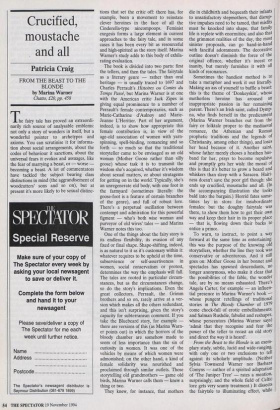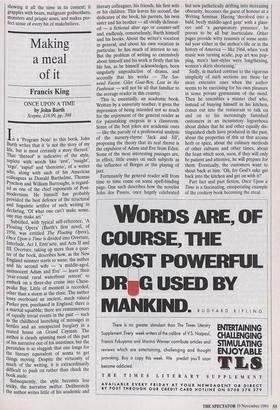Crucified, moustache and all
Patricia Craig
FROM THE BEAST TO THE BLONDE by Marina Warner Chatto, £20, pp. 458 The fairy tale has proved an extraordi- narily rich source of analysable emblems: not only a story of wonders in itself, but a wonderful pointer to archetypes and axioms. You can scrutinise it for informa- tion about social arrangements, about the codes of behaviour it sanctions, about the universal fears it evokes and assuages, like the fear of marrying a beast, or — worse becoming a beast. A lot of commentators have tackled the subject bearing class distinctions in mind (the aggrandisement of woodcutters' sons and so on), but at present it's more likely to be sexual distinc- tons that set the critic off: there has, for example, been a movement to reinstate clever heroines in the face of all the Cinderella-type nincompoops. Feminist exegesis forms a large element in current approaches to the fairy tale, and in some cases it has been every bit as resourceful and high-spirited as the story itself. Marina Warner's study adds to this body of exhila- rating evaluation.
The book is divided into two parts: first the tellers, and then the tales. The fairytale as a literary genre — rather than oral heritage — is usually traced to 1697 and Charles Perrault's Histoires ou Comes du Temps Passé, but Marina Warner is at one with the American critic Jack Zipes in giving equal prominence to a number of Perrault's female contemporaries, such as Marie-Catharine d'Aulnoy and Marie- Jeanne L'Heritier. Part of her argument, indeed, is to show how appropriate this female contribution is, in view of the age-old association of women with yarn- spinning, spell-binding, romancing and so forth — so much so that the traditional storyteller came to be envisaged as an old woman (Mother Goose rather than silly goose) whose task it is to transmit the wisdom she's acquired, whether it's wisdom about sexual matters, or about stratagems for getting on in the world.' Typically, she's an unregenerate old body, with one foot in the farmyard (sometimes literally: the goose-foot is a feature of certain branches of the genre), and full of robust lore. There's a perpetual oscillation between contempt and admiration for this powerful figment — who's both wise woman and purveyor of old wives' tales — and Marina Warner notes this too.
One of the things about the fairy story is its endless flexibility, its evasion of any fixed or final shape. Shape-shifting, indeed, is as natural to it as it's customary within it: whatever requires to be upheld at the time, subservience or self-assertiveness in women, social conservatism or protest, determines the way the emphasis will fall. The tales are rooted in particular circum- stances, but as the circumstances change, so do the story's implications. Even the great collectors, Perrault, the Grimm brothers and so on, rarely arrive at a ver- sion which makes all the others redundant, and this isn't surprising, given the story's capacity for subterranean comment. If you take the Bluebeard story, for example there are versions of this (as Marina Warn- er points out) in which the horrors of the bloody chamber are somehow made to seem of less importance than the sin of curiosity in women. It was one of the vehicles by means of which women were admonished; on the other hand, a kind of female solidarity was nourished and proclaimed through similar outlets. Those storytelling old grandmothers — game old birds, Marina Warner calls them — knew a thing or two.
They knew, for instance, that mothers die in childbirth and bequeath their infants to unsatisfactory stepmothers, that disrup- tive impulses need to be tamed, that misfits must be knocked into shape, that family life is replete with enormities; and also that the grimmest realities of the day, the most sinister proposals, can go hand-in-hand with fanciful adornments. The decorative outline doesn't diminish the force of the original offence, whether it's incest or inanity, but merely furnishes it with all kinds of resonances.
Sometimes the handiest method is to take a metaphor and work it out literally. Making an ass of yourself to baffle a beast: this is the theme of ‘Donkeyskin', whose motherless heroine has aroused an inappropriate passion in her remaining parent. There's an Irish saint, called DymP- na, who finds herself in the predicament (Marina Warner branches out from the fairy or folktale proper to the mediaeval romance, the Athenian and Roman prophetic traditions and the legends of Christianity, among other things), and loses her head because of it. Another saint, whose father merely choses a heathen hus- band for her, prays to become repulsive and promptly gets her wish: the moral of this is that it's better to grow a beard and whiskers than sleep with a Saracen. Hairi- ness doesn't save the poor girl though: she ends up crucified, moustache and all. (In the accompanying illustration she looks bald into the bargain.) Horrid fates some- times lay in store for insubordinate females: but the doughty fairytale was there, to show them how to get their own way and keep their hair in its proper place — that is, flowing down their backs to entice a prince.
To warn, to instruct, to point a way forward at the same time as entertaining: this was the purpose of the knowing old storytellers, whether the line they took was conservative or adventurous. And it still goes on: Mother Goose in her bonnet and spectacles has spawned descendants, no longer anonymous, who make it clear that the possibilities of the fable, the wonder tale, are by no means exhausted. There's Angela Carter, for example — an influen- tial presence in Marina Warner's book — whose pungent retellings of traditional stories in The Bloody Chamber of 1979 come chock-full of erotic embellishments; and Salman Rushdie, fabulist and reshape'', whose persecutors (Marina Warner says) `admit that they recognise and fear the power of the teller to recast an old story and direct the way it is heard'.
From the Beast to the Blonde is an exem- plary study, subtle, lucid and wide-ranging, with only one or two exclusions to tell against its scholarly amplitude. (Neither Sylvia Townsend Warner nor Barbara Comyns — author of a spirited adaptation of 'The Juniper Tree' — rates a mention, surprisingly; and the whole field of Celtic lore gets very scanty treatment.) It dissects the fairytale to illuminating effect, while showing it all the time in its context; it grapples with bears, malignant godmothers, monsters and priapic asses, and makes per- fect sense of every bit of makebelieve.



















































































 Previous page
Previous page